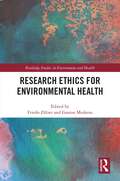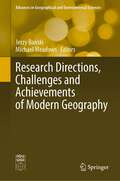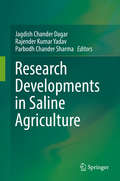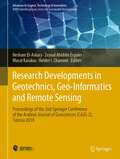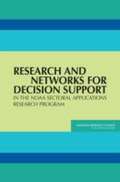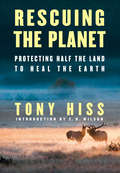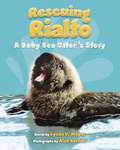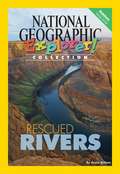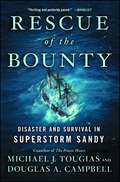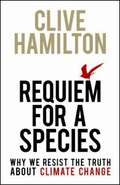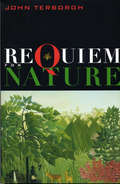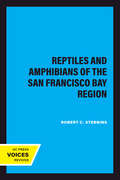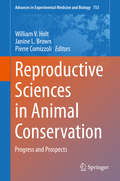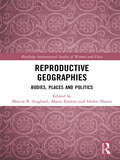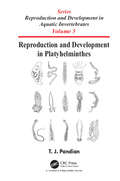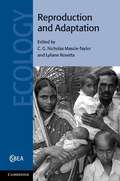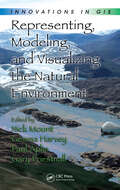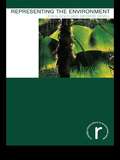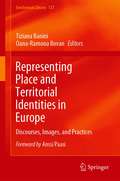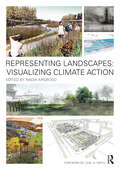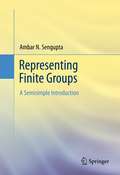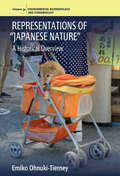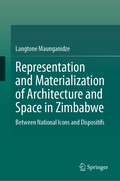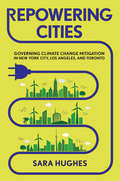- Table View
- List View
Research Ethics for Environmental Health (Routledge Studies in Environment and Health)
by Friedo ZölzerResearch Ethics for Environmental Health explores the ethical basis of environmental health research and related aspects of risk assessment and control. Environmental health encompasses the assessment and control of those environmental factors that can potentially affect human health, such as radiation, toxic chemicals and other hazardous agents. It is often assumed that the assessment part is just a matter of scientific research, and that control is a matter of implementing standards that unambiguously follow from that research. But it is less commonly understood that environmental health also requires addressing questions of an ethical nature. Coming from multiple disciplines and nine different countries, the contributors to this book critically examine a diverse range of ethical concerns in modern environmental health research. This book will be of great interest to scholars and practitioners of environmental health, as well as researchers in applied ethics, environmental ethics, medical ethics, bioethics and those concerned with chemical and radiation protection.
Research Ethics and Integrity During Pandemics: Developing the PREPARED Code (SpringerBriefs in Research and Innovation Governance)
by Kate Chatfield Michelle SinghThis open-access book is an essential read for anyone interested in pandemic preparedness, research governance, and the ethical oversight of research. It examines the development of a pioneering research ethics framework designed for use during pandemics, guiding readers through the careful development of the PREPARED Code, while highlighting the key steps and lessons learned. The book also underscores the importance of supportive measures, such as user-friendly ethics training, to ensure effective implementation. Drawing from these insights, it offers recommendations for others seeking to develop their own clear, engaging, and accessible ethics code.
Research Directions, Challenges and Achievements of Modern Geography (Advances in Geographical and Environmental Sciences)
by Michael Meadows Jerzy BańskiThis book identifies and discusses research directions, challenges and achievements in contemporary geography. It also documents the most current theoretical and methodological considerations undertaken by scientists representing various sub-disciplines of geography with particular reference to human geography. It was assumed that the thematic structure of the currently active International Geographical Union (IGU) problem commissions corresponds to the most relevant and current research directions in geography. Reflecting this assumption, the book consists of 14 chapters contributed by geographers representing 14 problem commissions of the IGU, which allows us to examine geography from different perspectives and to provide the reader with a complete overview of contemporary research issues in human geography. The first part discusses contemporary research problems and issues related to scientific methodology and achievements of selected geographical sub-disciplines, including urban geography, agricultural geography, transport geography, and political geography, among others. The second part focuses on the interdisciplinarity of geography and the topics of global dimension undertaken by geographers such as global change, GIS and geospatial technology, marginalization, and environmental change. This part also discusses the internal relations between geographical specializations and their links with other related sciences, including geology, sociology, and economics. The third part discusses the holistic approaches of geography applied to particular regions, territories, or conditions (Africa, costal systems, geomorphology and local development).
Research Developments in Saline Agriculture
by Jagdish Chander Dagar Rajender Kumar Yadav Parbodh Chander SharmaSoil and water salinity is a major challenge for the agricultural community and policy makers in terms of meeting the burgeoning population’s demand for food and other agricultural commodities. In coastal regions, climate change and sea level rise will aggravate the problem with more and more areas becoming saline due to intrusion of sea water. As such there is a pressing need for modern tools and innovative techniques for the identification of salty soils and poor-quality waters, crop production, soil reclamation and lowering the water table in waterlogged areas. Tackling next-generation problems such as contamination of soil and underground water due to fluoride and arsenic, as well as developing multi-stress tolerant crops is also a high priority. Further, techniques for domesticating halophytes, mangrove-based aquacultures, using seaweed cultures as agricultural crops and integrated farming systems need to be perfected. This book addresses all these aspects in detail, highlighting the diverse solutions to tackle the complex problem of salinity and waterlogging and safer management of poor-quality waters. With chapters written by leading experts, it is a valuable resource for researchers planning future investigations, policy makers, farmers and other stakeholders, and for students wanting insights into vital issues of environment.
Research Developments in Geotechnics, Geo-Informatics and Remote Sensing: Proceedings of the 2nd Springer Conference of the Arabian Journal of Geosciences (CAJG-2), Tunisia 2019 (Advances in Science, Technology & Innovation)
by Zeynal Abiddin Erguler Murat Karakus Helder I. Chaminé Hesham El-AskaryThis book contains the best peer-reviewed papers accepted for presentation at the 2nd Springer Conference of the Arabian Journal of Geosciences (CAJG-2), organized in Sousse, Tunisia, in November 2019. The short papers cover various topics from the fields of (1) geological and geotechnical engineering, (2) geomechanical studies based on numerical and analytical methods, and (3) geo-informatics and remote sensing. The content of these papers provides new scientific knowledge for further understanding on landslides, new stabilization techniques, importance of geophysics for engineering geology investigations as well as new empirical approaches for easily predicting some physical and hydrogeomechanical properties of geomaterials. The book is of interest to all researchers, practitioners, and students in the fields of geological and mining engineering, geotechnical engineering, hydrogeomechanics, engineering geology, geotechnologies, and natural hazards.
Research And Networks For Decision Support: In The Noaa Sectoral Applications Research Program
by National Research Council of the National AcademiesThis study recommends a definition of “decision support” that emphasizes communication rather than translation and a strategy by which the small NOAA Sectoral Applications Research program can advance decision support. The book emphasizes that seasonal climate forecasts provide fundamentally new kinds of information and that integrating this information into real-world decisions will require social innovations that are not easily accomplished. It recommends that the program invest in (a) research to identify and foster the innovations needed to make information about climate variability and change more usable in specific sectors, including research on the processes that influence success or failure in the creation of knowledge-action networks for making climate information; (b) workshops to identify, catalyze, and assess the potential of knowledge-action networks in particular resource areas or decision domains; and (c) pilot projects to create or enhance these networks for supporting decisions in climate-affected sectors. It recommends that evaluation of the program be addressed with a monitoring approach.
Rescuing the Planet: Protecting Half the Land to Heal the Earth
by Tony Hiss"As clear a picture of humanity's impact on earth's natural environment as any ever written." --E. O. Wilson (from the Introduction)An urgent, resounding call to protect 50 percent of the earth's land by 2050--thereby saving millions of its species--and a candid assessment of the health of our planet and our role in conserving it, from the award-winning author of The Experience of Place and veteran New Yorker staff writer.Beginning in the vast North American Boreal Forest that stretches through Canada, and roving across the continent, from the Northern Sierra to Alabama's Paint Rock Forest, from the Appalachian Trail to a ranch in Mexico, Tony Hiss sets out on a journey to take stock of the "superorganism" that is the earth: its land, its elements, its plants and animals, its greatest threats--and what we can do to keep it, and ourselves, alive.Hiss not only invites us to understand the scope and gravity of the problems we face, but also makes the case for why protecting half the land is the way to fix those problems. He highlights the important work of the many groups already involved in this fight, such as the Indigenous Leadership Initiative, the Yellowstone to Yukon Conservation Initiative, and the global animal tracking project ICARUS. And he introduces us to the engineers, geologists, biologists, botanists, oceanographers, ecologists, and other "Half Earthers" like Hiss himself who are allied in their dedication to the unifying, essential cause of saving our own planet from ourselves.Tender, impassioned, curious, and above all else inspiring, Rescuing the Planet is a work that promises to make all of us better citizens of the earth.
Rescuing Rialto: A Baby Sea Otter's Story
by Lynda V. Mapes"Calling all sea otter fans!" - KirkusOn a sunny August morning in 2016, a baby sea otter was found washed up on the sand. Orphaned and sick, Rialto was taken to the Seattle Aquarium, where his dedicated caretakers nursed him back to health and taught him how to be an otter. Soon, the charming Rialto was stealing hearts as he played with toys made of ide, swam in his very own pool, ate tasty clams, and floated on his back. Learn about the rescue--and how you can help to save this endangered species--in Rescuing Rialto, from the Seattle Times reporter and photographer who chronicled this story as it happened. Just as he captured them, Rialto's sure to steal your heart, too.
Rescue of the Bounty: Disaster and Survival in Superstorm Sandy (True Rescue Ser.)
by Michael J. Tougias Douglas A. CampbellFrom the author of the Fall 2015 Disney movie The Finest Hours, the “thrilling and perfectly paced” (Booklist) story of the sinking and rescue of Bounty—the tall ship used in the classic 1962 movie Mutiny on the Bounty—which was caught in the path of Hurricane Sandy with sixteen aboard.On Thursday, October 25, 2012, Captain Robin Walbridge made the fateful decision to sail Bounty from New London, Connecticut, to St. Petersburg, Florida. Walbridge knew that a hurricane was forecast, yet he was determined to sail. The captain told the crew that anyone could leave the ship before it sailed. No one took the captain up on his offer. Four days into the voyage, Superstorm Sandy made an almost direct hit on the ship. A few hours later, the ship suddenly overturned ninety miles off the North Carolina coast in the “Graveyard of the Atlantic,” sending the crew tumbling into an ocean filled with towering thirty-foot waves. The coast guard then launched one of the most complex and massive rescues in its history. In the uproar heard across American media in the days following, a single question persisted: Why did the captain decide to sail? Through hundreds of hours of interviews with the crew members and the coast guard, Michael J. Tougias and Douglas A. Campbell create an in-depth portrait of the enigmatic Captain Walbridge, his motivations, and what truly occurred aboard Bounty during those terrifying days at sea. “A white-knuckled, tragic adventure” (Richmond Times-Dispatch), Rescue of the Bounty is an unforgettable tale about the brutality of nature and the human will to survive.
Requiem for a Species: Why We Resist the Truth About Climate Change
by Clive HamiltonClive Hamilton offers a compelling description of a world transformed by climate change and explains why we won't stop climate change even though we know it will destroy us. This book does not set out to raise the alarm again to encourage us to take radical measures to head off climate chaos. There have been many books and reports in recent years explaining just how dire the future looks and how little time we have left to act. This book is about why we have ignored those warnings, and why it may now be too late. It is a book about the frailties of the human species as expressed in both the institutions we built and the psychological dispositions that have led us on the path of self-destruction. It is about our strange obsessions, our hubris, and our penchant for avoiding the facts. It is the story of a battle within us between the forces that should have caused us to protect the Earth, "our capacity to reason and our connection to Nature "and those that, in the end, have won out "our greed, materialism and alienation from Nature. And it is about the 21st century consequences of these failures.
Requiem for Nature
by John TerborghFor ecologist John Terborgh, Manu National Park in the rainforest of Peru is a second home; he has spent half of each of the past twenty-five years there conducting research. Like all parks, Manu is assumed to provide inviolate protection to nature. Yet even there, in one of the most remote corners of the planet, Terborgh has been witness to the relentless onslaught of civilization.Seeing the steady destruction of irreplaceable habitat has been a startling and disturbing experience for Terborgh, one that has raised urgent questions: Is enough being done to protect nature? Are current conservation efforts succeeding? What could be done differently? What should be done differently? In Requiem for Nature, he offers brutally honest answers to those difficult questions, and appraises the prospects for the future of tropical conservation. His book is a clarion call for anyone who cares about the quality of the natural world we will leave our children.Terborgh examines current conservation strategies and considers the shortcomings of parks and protected areas both from ecological and institutional perspectives. He explains how seemingly pristine environments can gradually degrade, and describes the difficult social context -a debilitating combination of poverty, corruption, abuses of power, political instability, and a frenzied scramble for quick riches -in which tropical conservation must take place. He considers the significant challenges facing existing parks and examines problems inherent in alternative approaches, such as ecotourism, the exploitation of nontimber forest products, "sustainable use," and "sustainable development."Throughout, Terborgh argues that the greatest challenges of conservation are not scientific, but are social, economic, and political, and that success will require simultaneous progress on all fronts. He makes a compelling case that nature can be saved, but only if good science and strong institutions can be thoughtfully combined.
Reptiles and Amphibians of the San Francisco Bay Region (California Natural History Guides #3)
by Robert C. StebbinsThis title is part of UC Press's Voices Revived program, which commemorates University of California Press’s mission to seek out and cultivate the brightest minds and give them voice, reach, and impact. Drawing on a backlist dating to 1893, Voices Revived makes high-quality, peer-reviewed scholarship accessible once again using print-on-demand technology. This title was originally published in 1959.This title is part of UC Press's Voices Revived program, which commemorates University of California Press’s mission to seek out and cultivate the brightest minds and give them voice, reach, and impact. Drawing on a backlist dating to 1893, Voices Revived</DIV
Reproductive Sciences in Animal Conservation
by William V. Holt Janine L. Brown Pierre ComizzoliReproductive biology is more than the development of techniques for helping with too little or too much breeding. While some of the relevant techniques are useful for individual species, technical developments have to be backed up by thorough biological understanding of the background behind the problems. This book is therefore threefold; (1) it provides a snapshot of the state of the art in terms of species-specific reproductive technologies, whether for individual animals or whole taxonomic groups; (2) it sets the reproductive problems in context and emphasizes the links between animal-based problems and the wider world, e. g. reproductive fitness and (3) it looks forward and presents realistic assessments of how effective some of the more recently developed techniques in reproductive technology might be at combating extinctions. This is a wide-ranging book that will be relevant to anyone involved in reproductive biology or in species conservation and provides provide them some useful perspectives about the real utility of current and emerging technologies. It has contributions from experts in reproduction and related fields.
Reproductive Geographies: Bodies, Places and Politics (Routledge International Studies of Women and Place)
by Helen Hazen Marcia R. England Maria FanninThe sites, spaces and subjects of reproduction are distinctly geographical. Reproductive geographies span different scales - body, home, local, national, global - and movements across space. This book expands our understanding of the socio-cultural and spatial aspects of fertility, pregnancy and birth. The chapters directly address global perspectives, the future of reproductive politics and state-focused approaches to the politicisation of fertility, pregnancy and birth. The book provides up-to-date explorations on the changing landscapes of reproduction, including the expansion of reproductive technologies, such as surrogacy and intrauterine insemination. Contributions in this book focus on phenomenologically-inspired accounts of women’s lived experience of pregnancy and birth, the biopolitics of birth and citizenship, the material histories of reproductive tissues as "scientific objects" and engagements with public health and development policy. This is an essential resource for upper-level undergraduates and graduates studying topics such as Sociology, Geographies of Gender, Women’s Studies and Anthropology of Health and Medicine.
Reproduction and Development in Platyhelminthes (Reproduction and Development in Aquatic Invertebrates)
by T. J. PandianThis book is a comprehensive elucidation on aspects of reproduction and development in platyhelminthes covering from acoelids to taeniids. With the unique presence of neoblasts, turbellarians serve as a model for studies on cancer and senescence. Of ~ 27,000 species, ~ 77% are parasites; they are harmful to man and his food basket from livestock and fish. The stress hormone, cortisol level is responsible for susceptibility and resistance of the host. In digeneans, the propagatory multiplication potency is retained by all the larval forms and in either direction in sporocyst. The higher clonal diversity, mixing and selection in Second Intermediate Host (SIH) may purge inbreeding depression suffered by the fluke on propagatory multiplication in First Intermediate Host (FIH). Of 12,012 digeneans, 88% may engage 33,014 potential SIH species. They have the choice to select one among the available/awaiting 3.5 host species. The motility of vertebrate host and euryxenic flexibility/scope for selection of SIH species has increased lineage diversification in digeneans. The life cycle of cestodes is divided into aquatic and terrestrial patterns. The former includes (i) oncosphere and (ii) coracidium types and the latter (iii) hexacanth-cysticercoid, (iv) hexacanth-tetrathyridium and (v) hexacanth-cysticercus types. The share for the oncosphere, coracidium and hexacanth types is 17.0, 29.5 and 46.5%, respectively. The staggering fecundity and adoption of the intermediate host in the herbivorous/insectivorous food chain have enriched Taenioidea as the most (2,264) speciose order. Sex specific genes Smed-dmd 1 and macbol have been identified, and neuropeptides and dipeptides are involved in sexualization. Trematodes are unable to parasitize elasmobranchs, as they cannot suck body fluid/blood containing a high level of urea. Relatively higher fecundity supplemented with propagatory multiplication, incorporation of SIH in 88% species, clonal selection in SIH, and euryxenic flexibility and the widest choice for selection of SIH have led to the highest lineage diversification to render digeneans as the most speciose order in Platyhelminthes.
Reproduction and Adaptation
by C. G. Mascie-Taylor Lyliane RosettaIn the space of one generation major changes have begun to take place in the field of human reproduction. A rapid increase in the control of fertility and the understanding and treatment of sexual health issues have been accompanied by an emerging threat to reproductive function linked to increasing environmental pollution and dramatic changes in lifestyle. Organised around four key themes, this book provides a valuable review of some of the most important recent findings in human reproductive ecology. Major topics include the impact of the environment on reproduction, the role of physical activity and energetics in regulating reproduction, sexual maturation and ovulation assessment and demographic, health and family planning issues. Both theoretical and practical issues are covered, including the evolution and importance of the menopause and the various statistical methods by which researchers can analyse characteristics of the menstrual cycle in field studies.
Representing, Modeling, and Visualizing the Natural Environment (Innovations in GIS)
by Nick Mount Gemma Harvey Paul Aplin Gary PriestnallThe explosion of public interest in the natural environment can, to a large extent, be attributed to greater public awareness of the impacts of global warming and climate change. This has led to increased research interest and funding directed at studies of issues affecting sensitive, natural environments. Not surprisingly, much of this work has re
Representing the Environment (Routledge Introductions to Environment: Environment and Society Texts)
by George Revill John R. GoldThe development of the environmental movement has relied heavily upon written and visual imagery. Representing the Environment offers an introductory guide to representations of the environment found in the media, literature, art and everyday life encounters. Featuring case studies from Europe, the Americas and Australia, Representing the Environment provides practical guidance on how to study environmental representations from a cultural and historic perspective, and places the reader in the role of active interpreter. The book argues that studying representations provides an important lens on the development of environmental attitudes, values and decision-making.
Representing Place and Territorial Identities in Europe: Discourses, Images, and Practices (GeoJournal Library #127)
by Tiziana Banini Oana-Ramona IlovanThis book provides insight into the topic of place and territorial identity, which involves both the dimension of collective belonging and the politics of territorial planning and enhancement. It considers the social, economic and political effects of territorial identity representations among others in terms of mystification, spatial fetishism, and the creation of place and territorial stereotypes. A mixed methodology is employed to research case studies at diverse territorial scales which are relevant to the impact of a variety of factors on place/territorial identity processes such as migration, political and economic changes, natural disasters, land use changes, etc. Visual imagery, constructing visual discourses and living within visual cultures are placed in the foreground and refer to among others the changes and challenges introduced by the Internet and social networks in place/territory representations and self-representations; identity politics and its impact on place/territorial identity representations; discourses in shaping representations and self-representations of territorial/place-based identities related to collective memory, cultural heritage, invented tradition, imagined communities and other key notions.
Representing Landscapes: Visualizing Climate Action (Representing Landscapes)
by Nadia AmorosoThis book provides an in-depth overview of graphic and visual communication styles for conveying climate change and climate action within the landscape architectural profession and in academia. The book features visualizations of climate adaptation and resilience, developed by award-winning landscape architects and academics from Canada, the United States, the United Kingdom, The Netherlands, Denmark, Germany, Italy, France, Finland, South Africa, Singapore, and China. Representing Landscapes: Visualizing Climate Action illustrates the imaginative ways in which climate action and climate resilient concepts are visually presented, communicated, and perceived. The book will be especially valuable for students and practitioners in landscape architecture, urban planning, and related fields to understand how to visually capture climate change issues and design solutions, and to deliver this message to the public.
Representing Finite Groups
by Ambar N. SenguptaThis graduate textbook presents the basics of representation theory for finite groups from the point of view of semisimple algebras and modules over them. The presentation interweaves insights from specific examples with development of general and powerful tools based on the notion of semisimplicity. The elegant ideas of commutant duality are introduced, along with an introduction to representations of unitary groups. The text progresses systematically and the presentation is friendly and inviting. Central concepts are revisited and explored from multiple viewpoints. Exercises at the end of the chapter help reinforce the material. Representing Finite Groups: A Semisimple Introduction would serve as a textbook for graduate and some advanced undergraduate courses in mathematics. Prerequisites include acquaintance with elementary group theory and some familiarity with rings and modules. A final chapter presents a self-contained account of notions and results in algebra that are used. Researchers in mathematics and mathematical physics will also find this book useful. A separate solutions manual is available for instructors.
Representations of “Japanese Nature”: A Historical Overview (Environmental Anthropology and Ethnobiology)
by Emiko Ohnuki-Tierney“Nature” as a concept and word is extremely elusive, yet it is commonly taken for granted that “the pristine nature” is “out there.” This book explores the factors that have naturalized the idea of nature as “pristine” into our psyche, and as something that has a spatial, visual, and temporal dimension for “seasons”. Much emphasis is given to the inhabitants demonstrating the dynamic characteristic of nature. As a study done over a long period of history, Representations of “Japanese Nature” shows the mutual support between conceptual principles of nature and the daily activities of the people .
Representation and Materialization of Architecture and Space in Zimbabwe: Between National Icons and Dispositifs
by Langtone MaunganidzeThis volume is an empirical study examining the extent to which historic and iconic architecture and spaces in Zimbabwe - particularly in urban areas - have been mobilized to construct and reconstruct identities. The author explores the question of traditional and political architecture through analysis of a variety of structures, including monuments, museums, and indigenous and state buildings. Special attention is paid to the soapstone-carved Zimbabwe Bird, which for years has served as the national emblem. Overall, this book argues that while the production and use of architectural products and spaces have been regarded symbols of collective identity, they have also served as expressions of power and control.
Repowering Cities: Governing Climate Change Mitigation in New York City, Los Angeles, and Toronto
by Sara HughesCity governments are rapidly becoming society's problem solvers. As Sara Hughes shows, nowhere is this more evident than in New York City, Los Angeles, and Toronto, where the cities' governments are taking on the challenge of addressing climate change.Repowering Cities focuses on the specific issue of reducing urban greenhouse gas (GHG) emissions, and develops a new framework for distinguishing analytically and empirically the policy agendas city governments develop for reducing GHG emissions, the governing strategies they use to implement these agendas, and the direct and catalytic means by which they contribute to climate change mitigation. Hughes uses her framework to assess the successes and failures experienced in New York City, Los Angeles, and Toronto as those agenda-setting cities have addressed climate change. She then identifies strategies for moving from incremental to transformative change by pinpointing governing strategies able to mobilize the needed resources and actors, build participatory institutions, create capacity for climate-smart governance, and broaden coalitions for urban climate change policy.
